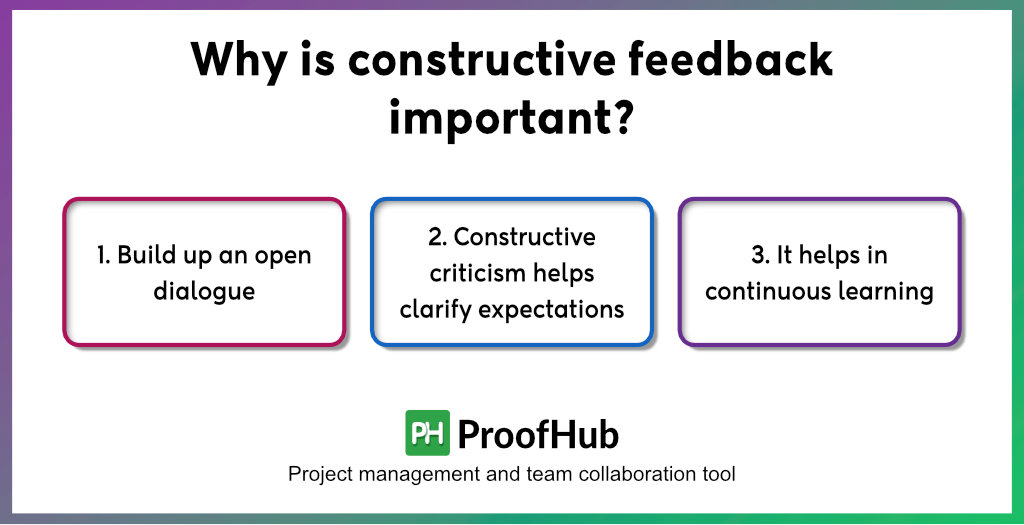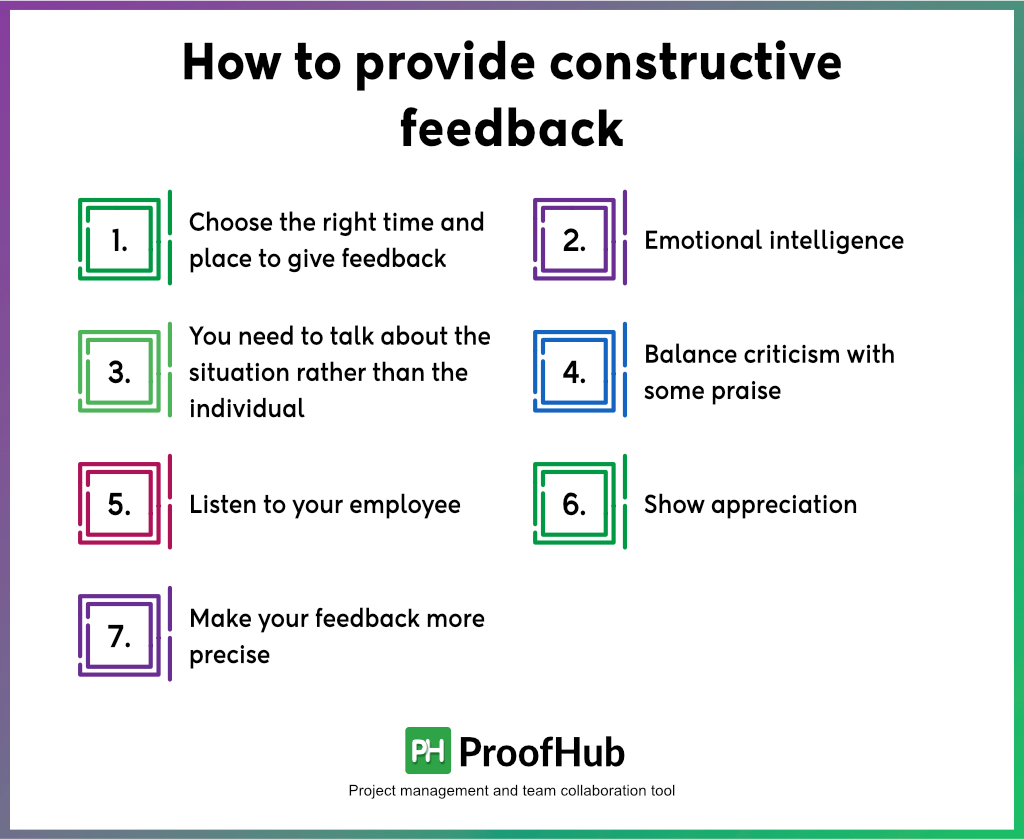Providing constructive feedback is essential for fostering growth and improvement among team members. However, many managers struggle with delivering feedback effectively, often leading to misunderstandings or demotivation.
In this article, we’ll explore the importance of constructive feedback, examples, and practical strategies for delivering feedback, that inspire positive change and promote professional development.
What is constructive feedback?
Constructive feedback is the process of providing actionable insights to individuals regarding their performance or behavior. It aims to help them identify areas for improvement, develop their skills, and foster positive growth. Unlike criticism, constructive feedback focuses on solutions and encouragement rather than solely pointing out shortcomings.
Providing feedback is an important part of the work culture. Positive feedback is given so that the employees’ enthusiasm can be boosted. However, giving feedback that is not constructive is not an easy task because even well-experienced managers struggle to provide constructive feedback. They do not know how to provide feedback as they often use words that sound like criticism, therefore it can negatively impact relationships with employees.
So what is the best way to give effective feedback that encourages employees to perform better at work and build their confidence? Well, here you can follow the tips I have shared below with you.
But before that, let’s understand the importance of constructive feedback.
Why is constructive feedback important?
It does not matter if you are a manager in a large or small organization, a beginner, or an experienced one; providing well-structured feedback can help strengthen your team. Here are the benefits it includes:

1. Build up an open dialogue
Giving feedback that is positive and constructive assists in building up an open dialogue between managers as well as employees. If managers provide unbiased feedback, then this can also help build trust between both parties. By embracing positive feedback, you can have the opportunity to understand each other better, therefore also improving communication between you and your employees.
To make it even easier and simpler to communicate as well as collaborate with your team, you can use PoofHub as it is an all-in-one work management and team collaboration tool. Here is how you can use ProofHub to give constructive feedback:
Discussions
ProofHub can help you in conversation regarding any projects with its discussion option. This option also enables you to concentrate on the specific matter where you can provide feedback to your employees, and share ideas as well as documents with them. So, this way, you can also save time and not have to use those long emails.
File Proofing
To make employee feedback more constructive, you can use the proofing option offered by ProofHub as it helps managers to give feedback on designs and documents. For proofing a file, you can use markup tools and threaded comments as well.
2. Constructive criticism helps clarify expectations
The process of providing positive feedback includes recognizing any weaknesses or issues your employees are having and offering solutions to those conflicts. As of this procedure, employees can know how project managers anticipate them to perform their jobs. Therefore, this employee feedback works as directing employees and making sure that they fulfill those expectations in the future.
3. It helps in continuous learning
Often employees cannot focus on education and learning new things as they develop the habit of repetitive and boring work routines. So, by providing effective feedback regularly, including mentioning and identifying which areas can be improved through training, your employees would learn new things.
How to provide constructive feedback and make a positive impact
Below you can go through a list of tips that can help you provide productive feedback to your employees:
When you want to give feedback to the employee, you have to keep some important points in mind to deliver positive feedback.

Deliver your feedback in a way that everyone feels positive when they get out of the feedback session. Here are the best ways to give it:
1. Choose the right time and place to give feedback
The first thing that you need to do is choose the right place. The small appreciation feedback can be given to other team members. But when you have to include some criticism in your feedback, then it is best to do it in a one-on-one meeting. This way, team members would not feel embarrassed among other team members.
Time is also important to choose while providing feedback. You should give feedback as soon as possible when all the things are clear. There is no need to wait when you think it is the right time because the longer you delay, the less your feedback will be constructive.
For managers, it is the right time to give recognition to the accomplishment of an employee while it has been recently achieved. And if you have to provide negative feedback, then your feedback should also be timely. To give negative feedback, you need to wait until you have got your emotions under control. This can assist in making your feedback look more objective rather than biased.
2. Emotional Intelligence
One of the crucial things to remember before you provide feedback to your employees is that you need to think about your emotional state. For example, if you are feeling emotions of anger, then it could result in inappropriate negative feedback. Hence, becomes important that before giving effective criticism, work on how it can affect you and the recipient.

3. You need to talk about the situation rather than the individual
The feedback can be constructive if it is more about the results rather than biased thoughts about an employee’s traits. If the feedback is focused on the recipient, then this can be considered a personal attack inspired by personal emotions.
Therefore, it becomes clear that you should focus on the situation. Focusing on the situation makes sure that you are only here to solve the issue rather than criticizing the traits of your employee.
4. Balance criticism with some praise
To deliver the best constructive feedback, you need to balance the criticism with some praise. Overwhelming an individual with criticism can result in him or her being defensive or even shutting them down. Not to mention that you would also lose the opportunity to make them engage in discussing the areas to be worked on.
Praising your employees that they do great work is as important as it is making them aware of where they need to improve.
So, when there is a time to end the session, remember to close it with a positive note. This can help in improving the engagement and enthusiasm of the employee while you will still be able to have your matter across.
5. Listen to your employee
When it comes to giving the best feedback, it is also imperative that your employees can respond to it and have an opinion about it. By creating a conversation with your employee, you acknowledge that you are ready to hear it from the employee’s perspective and what he or she thinks or what his or her concerns are. So, overall listening to a concerned employee provides a chance for him to show you what he thinks and makes him a part of the solution.
6. Show appreciation
While you give constructive criticism, you must praise the work or efforts done by your employees. By emphasizing your employee’s working qualities, you can help them improve their confidence level. Providing your feedback in a positive as well as appreciative manner can make them more open-minded to your remarks rather than feeling bashed with negative comments.
7. Make your feedback more precise
For feedback to be fully constructive, you should tell them why it is important instead of telling them what they could do.
For instance, it is needless to say an employee should come to the office at the right time because he already knows that timeliness is important. But you can instead concentrate on the real issues like; customers waiting for a long time. It would be best if you could frame your feedback where the real problem lies.
It might be possible that an employee cannot know an issue. That is why in this case, it becomes essential to give employees a feeling of how this particular issue can impact you as well as the rest of your business. All I want to say on this point is that the more detailed and precise you make your feedback, the more it will be constructive.
With the help of ProofHub, you can give more precise feedback to your employees regarding their work. ProofHub has a powerful online proofing tool and you can use it to give feedback on files quickly and without any hassle. Using this option you can mark the file or design on the area it needs improvement and even can add comments in the form of feedback.
Constructive feedback examples with scenarios
The feedback that is constructive heavily depends on the choice of your words. Apart from this, strong communication as well as emotional intelligence is also one of the main factors in giving positive feedback. To help you in providing constructive criticism to your employees here are the different scenarios, So let’s explore these:
Scenario 1: John is a capable and dedicated employee, but lately, he has been lacking in work performance and is not fully focused on work, therefore delivering the projects after the deadline. Instead of admonishing, you need to assure him that you have seen his work behavior change and would love to find the solution for it.
Feedback: “John, I know how committed you are to your work and we are really happy that people like you are working in our organization. But recently I have noticed that you are not able to fully concentrate on your work and therefore are missing the deadlines for your assignments. But that is not like you as you always finish your work before the deadline. That is why I have decided that I want to discuss with you if you are facing any problems regarding your work so I can help you with that.”
Scenario 2: Andrew is an employee who is very good at his work, but recently he has been showing up late at the office. Coming into the office means that he is missing important details regarding work, thus this is affecting the workflow of the entire team. So, now in this situation, you need to make him aware of this matter and know what is the reason behind it, and explain how his coming late is affecting your entire team.
Feedback: “Andrew, I have noticed that you are showing up at the office late, therefore missing important information regarding work that was discussed in the meeting. This can affect your work and the workflow of the entire team. I see that you have been performing well at your work for the past few months, but you can do even better if you come to the office at the right time.”
You are also free to discuss with me if there is something that is affecting your arrival at the office. We can also work on making a plan so that you do not miss any future meetings and have updated information regarding your work.”
Scenario 3: Austin is working remotely and is not responding to any messages and emails regarding work. Not cooperating with leadership does not enable them to know if he has started working on a project. So if you are working in this kind of environment where you are unable to meet physically, then you need to make sure that you emphasize regular virtual meetings with him.
Feedback: “Austin, last week I emailed you to know the status of your project, but I have not received any answer from you. I am unable to get any information regarding your project. To ensure that everyone is on the right track and does not miss the deadline, I would appreciate it if you responded to these emails.
If you are facing any trouble regarding your work, then you are free to discuss it with me and I would love to find a solution for that so that we do not miss any deadline in the future.”
It does not matter if your employees are working remotely or not, ProofHub always works as the best problem-solving solution. It helps to keep the managers as well as employees on the same track as they can collaborate on the projects more effectively.
By using ProofHub, employees can simply change the status of the projects. Managers can use the Gantt charts, and file management, join discussions, and also can track the time their employees are spending on a particular project. Hence, this tool is best fit to have all the information in one place and to deliver the projects on time.
Scenario 4: For the past few days Stephen has been showing a disrespectful attitude towards his colleagues. This is having a negative impact on the office. So, you need to handle this matter carefully by remembering that addressing negativity in the workplace can improve employees’ morale.
Feedback: “Stephen, I have noticed that for the past few days, your behavior towards employees is not very good. Are you not feeling happy at work? Or is there something else that is bothering you? You can come to me for the discussion as I am always here to help you.”
Scenario 5: Tom has not been accomplishing his goals lately. But he is very good at what he does. So, in this situation, you need to recognize his best work and offer a solution that is best for him.
Feedback: “Tom I can see that you have achieved some fantastic results in the past. But, lately, you have not been able to accomplish any sales objectives for the last two months. I think we should discuss this and work on planning goals that are more manageable for you. And if we see that there is an improvement, then you should again work on accomplishing those same-size goals.”
Provide the constructive feedback to your employees, Try ProofHub Now!
Conclusion
Giving feedback to employees lets them know that you care about their work and performance. But, when we talk about making it more constructive, then it is completely a different thing as you need to ensure that it does not seem derogatory even if it is negative feedback.
All those points explained above on how to provide constructive feedback as well as the examples of constructive criticism, I am sure that whenever you have to give feedback, it will be easier for you to make it constructive by remembering all those main points.
In the end, I want to say making your feedback more constructive is all about focusing on the situation and behavior rather than people or personalities. It works by making employees aware of their mistakes and encouraging them to accomplish their goals.
FAQs:
What is the difference between constructive feedback and criticism?
Criticism is a statement that expresses dissatisfaction with someone’s acts or behaviors. Constructive feedback can also point out an employee’s shortcomings, but the focus is on how to improve performance.
When Should You Give Constructive Feedback?
The ideal time to provide feedback is as soon as possible as the longer you delay to schedule the meeting, the less constructive the feedback will be.
What are the most important elements of constructive feedback?
1) Comprehend employees’ perspective. 2) Believe that all employees are trying to do the right thing. 3) Instead of focusing on the individual, concentrate on the relevant facts.
The benefits of giving constructive feedback in real-time
Providing Constructive feedback in real-time to employees enhances motivation, allows for personal development, and boosts productivity. Managers who fail to do so risk substantial employee turnover and discontent.

